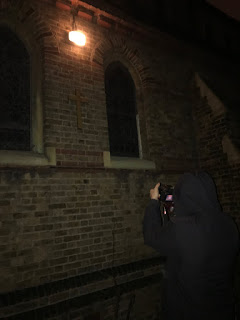Lighting in our final piece:
The location of our final piece was in an underground cellar which provided us with no natural light. This worked to our advantage in a way as it meant we would not have to worry about the changes in light, which would occur throughout the day. However, this meant we had to use our creative initiative to provide our own lighting.
We gained the majority of our lighting through candle light as this granted a natural, warm glow which made the location seem more realistic:
This was effective as the warmness of the candles produced an eerie atmosphere due to the shadows created which highlighted the authenticity of the walls and the cracks within them. However, this candle light was not powerful enough to light the whole room so we had to improvise. We did not own any professional lighting equipment therefore we resulted to the torch on our phone. However, we realised that this created a light which was too white and dissipated the warm tones we were aiming for. Therefore we covered the light with a piece of yellow paper to act as filter. This ended up working very effectively and lighted up the whole environment fully whilst giving it an eerie appearance.
We also liked the fact that the lighting produced many shadows around the room giving it depth which ensures some areas are darkened making it compliment the genre perfectly.









